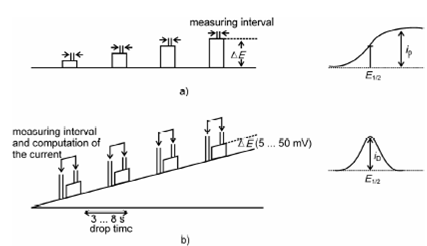Differential pulse voltammetry:
A higher detection limit in this technique is due to superior discrimination against charging current and impurity Faradaic current.
A peak current in differential pulse polarography is given by

where, ip = Peak current, n = Number of exchanged electrons, F = Faraday constant, R = Gas constant, T = Temp. In Abs. Scale, A = Electrode surface area, Ca = Concentration of the analyte, ? EA = Pulse amplitude, D = Diffusion coefficient of the analyte, and tp = Pulse duration.
The detection limit for the determination by this technique is similar to square wave polarography at 10-7 - 10-8 mol/dm3. Other than for irreversible reaction it is lowered.

Figure: Pulse application measuring procedure and current potential curves for (a) Normal pulse voltammetry; and (b) Differential pulse voltammetry